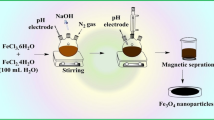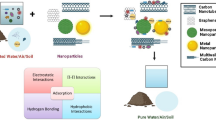Abstract
The preparation of magnetic nanoparticles (MNPs) coated with a layer of octadecyl group-modified silica containing multiwalled carbon nanotubes (MWCNTs) is described. Synthesis was accomplished by in-situ high temperature decomposition of the precursors ferric ion, octadecyltrichlorosilane (C18) and MWCNTs in ethylene glycol solvent. Transmission electron microscopy confirmed that the MNPs are encapsulated in the composite silica coating. These MNPs were used for clean-up of maize samples and the preconcentration of zearalenone and its secondary metabolites, namely β-zearalenol, β-zearalanol, α-zearalenol, α-zearalanol, and zearalanone at trace levels, prior to their determination by liquid chromatography-mass spectrometry. A comparative study of analyte adsorption and desorption was conducted with MNPs prepared with and without C18 and showed both solid phases to adsorb the analytes to some extent, but higher recoveries were obtained by using the C18-modified MNPs which therefore was selected for extraction of the mycotoxins. Under the optimum conditions, the MNPs can be re-used 6 times at least without loss of their extraction efficiency. Preconcentration factors are ~25, detection limits range from 0.6 to 1.0 μg mL−1, recoveries from spiked samples from 91.6 to 98.3 %, and relative standard deviations are <3.9 %.

Mycotoxins were selectively extracted on magnetic multiwalled carbon nanotube nanoC18SiO composites, and sensitively determined by liquid chromatography-mass spectrometry (LC- MS). The method meets the requirements established by the European Commission Directive 856/2005/EC.




Similar content being viewed by others
References
Fernando de Andrés F, Zougagh M, Castañeda G, Ríos A (2008) Determination of zearalenone and its metabolites in urine samples by liquid chromatography with electrochemical detection using a carbon nanotube-modified electrode. J Chromatogr A 1212:54–60
Krska R, Molinelli A (2007) Mycotoxin analysis: state-of-the-art and future trends. Anal Bioanal Chem 387:145–148
Lone KP (1997) Natural sex steroids and their xenobiotic analogs in animal production. Growth, carcass quality, pharmacokinetics, metabolism, mode of action, residues, methods and epidemiology. Crit Rev Food Sci Nutr 37:93–209
Cigić IK, Prosen H (2009) An overview of conventional and emerging analytical methods for the determination of mycotoxins. Int J Mol Sci 10:62–115
Hussein HS, Brasel JM (2001) Toxicity, metabolism and impact of mycotoxins on humans and animals. Toxicology 167:101–134
Marin S, Ramos AJ, Cano-Sancho G, Sanchis V (2013) Mycotoxins: occurrence, toxicology and exposure assessment. Food Chem Toxicol 60:2297–2303
Rodriguez-Carrasco Y, Ruiz MJ, Font G, Berrada H (2013) Exposure estimates to Fusarium mycotoxins through cereals intake. Chemosphere 93:218–237
Zain ME (2011) Impact of mycotoxins on humans and animals. J Saudí Chem Soc 15:129–144
Commission Regulation (EC) No 856/2005 amending Regulation (EC) No 466/2001 as regards Fusarium Toxins. European Union, Brussels
Josephs RD, Schuhmacher R, Krska R (2001) Determining mycotoxins and mycotoxigenic fungi in food and feed. Food Addit Contam 18:417–430
Tanaka T, Yoneda A, Inoue S, Sugiura Y, Ueno Y (2000) Simultaneous determination of trichothecene mycotoxins and zearalenone in cereals by gas chromatography–mass spectrometry. J Chromatogr A 882:23–28
Briones D, Gómez L, Cueva R (2007) Zearalenone contamination in corn for human consumption in the state of Tlaxcala. Mexico Food Chem 100:693–698
Mateo JJ, Mateo R, Hinojo MJ, Llorens A, Jiménez M (2002) Liquid chromatographic determination of toxigenic secondary metabolites produced by Fusarium strains. J Chromatogr A 955:245–256
Pallaroni L, Von Holst CH (2003) Comparison of alternative and conventional extraction techniques for the determination of zearalenone in corn. Anal Bioanal Chem 376:908–912
Cunnif P (1995) AOAC official methods of analysis, vol 49. AOAC International, Arlington, pp 45–46
Urraca JL, Marazuela MD, Merino ER, Orellana G, Moreno-Bondi MC (2006) Molecular imprinted polymers with a streamlined mimic for zearalenone analysis. J Chromatogr A 1116:127–134
Radova Z, Hajslova J, Kralova J, Papouskova L, Sykorova S (2001) Cereal Res Commun 29:435–442
Maragos CM, Appell M (2007) Capillary electrophoresis of the mycotoxin zearalenone using cyclodextrin-enhanced fluorescence. J Chromatogr A 1143:252–257
Urraca JL, Marazuela MD, Moreno-Bondi MC (2004) Analysis of zearalenone and α-zearalenol in cereals and swine feed using accelerated solvent extraction and liquid chromatography with fluorescence detection. Anal Chim Acta 524:175–183
Zougagh M, Ríos A (2008) Supercritical fluid extraction of macrocyclic lactone mycotoxins in maize flour samples for rapid amperometric screening and alternative liquid chromatographic method for confirmation. J Chromatogr A 1177:50–57
Ying YF, Wu YL, Wen Y, Yang T, Xu XQ, Wang YZ (2013) Simulteneous determination of six resorcyclic acid lactones in feed using liquid chromatography-tandem mass spectrometry and multiwalled carbon nanotubes as dispertive solid phase extraction sorbent. J Chromatogr A 1307:41–48
Bouri M, Gurau M, Salghi R, Cretescu I, Zougagh M, Ríos A (2012) Ionic liquids supported on magnetic nanoparticles as a sorbent preconcentration material for sulfonylurea herbicides prior to their determination by capillary liquid chromatography. Anal Bioanal Chem 404:1529–1538
Shen HY, Zhu Y, Wen XE, Zhuang YM (2007) Preparation of Fe3O4-C18 nano-magnetic composite materials and their cleanup properties for organophosphorous pesticides. Anal Bioanal Chem 387:2227–2237
Liu Y, Li H, Lin JM (2009) Magnetic solid-phase extraction based on octadecyl functionalization monodisperse magnetic ferrite microspheres for the determination of polycyclic aromatic hydrocarbons in aqueous samples coupled with gas chromatography–mass spectrometry. Talanta 77:1037–1042
Zhang Z, Yang X, Chen X, Zhang M, Luo L, Peng M, Yao S (2011) Novel magnetic bovine serum albumin imprinted polymers with a matrix of carbon nanotubes, and their application to protein separation. Anal Bioanal Chem 401:2855–2863
Gao C, Li WW, Morimoto H, Nagaoka Y, Maekawa TJ (2006) Magnetic carbon nanotubes: synthesis by electrostatic self-assembly approach and application in biomanipulations. J Phys Chem B 110:7213–7220
Correa-Duarte MA, Grzelczak M, Salgueirino-Maceira V, Giersig M, Liz-Marzán LM, Farle M, Sierazdki K, Diaz R (2005) Alignment of carbon nanotubes under low magnetic fields through attachment of magnetic nanoparticles. J Phys Chem B 109:19060–19063
Huiqun C, Meifang Z, Yaogang L (2006) Novel carbon nanotube iron oxide magnetic nanocomposites. J Magn Magn Mater 305:321–324
Morales-Cid G, Fekete A, Simonet BM, Lehmann R, Cardenas S, Zhang X, Valcárcel M, Schmitt-Kopplin P (2010) In situ synthesis of magnetic multiwalled carbon nanotube composites for the clean-up of (fluoro)quinolones from human plasma prior to ultrahigh pressure liquid chromatography analysis. Anal Chem 82:2743–2752
Gao L, Chen L (2013) Preparation of magnetic carbon nanotubes for separation of pyrethroids from tea samples. Microchim Acta 180:423–430
Bunkoed O, Kanatharana P (2015) Extraction of polycyclic aromatic hydrocarbons with a magnetic nanomaterials sorbent composed of alginate, magnetite nanoparticles and multiwalled carbon nanotubes. Microchim Acta 182:1519–1526
Fang GZ, Tan J, Yan XP (2005) An ion-imprinted functionalized silica gel sorbent prepared by a surface imprinting technique combined with a sol–gel process for selective solid-phase extraction of cadmium (II). Anal Chem 77:1734–1739
Mitterbauer R, Weindorfer H, Safaie N, Krska R, Lemmens M, Ruckenbauer P, Kuchler K, Adam G (2003) A sensitive and inexpensive yeast bioassay for the mycotoxin zearalenone and other compounds with estrogenic activity. Environ Microbiol 69:805–811
Schuhmacher R, Krska M, Grasserbauer W, Edinger W, Lew H (1998) Immuno-affinity columns versus conventional clean-up: a method comparison study for the determination of zearalenone in corn. Fresenius J Anal Chem 360:241–245
Wilcox J, Donnelly C, Leeman D, Markey E (2015) The use of immunoaffinity columns connected in tandem for selective and cost-effective mycotoxin clean-up prior to multi-mycotoxin liquid chromatographic-tandem mass spectrometric analysis in food matrices. J Chromatogr A 1400:91–97
European commission (EC) (2006) Commission regulation (EC) N° 1881/2006 of 19 December 2006 setting maximum levels for certain contaminants in foodtuffs. Off J Eur Union L364:5–31
Acknowledgments
The Spanish Ministry of Economy and Competitiveness (MINECO) and JJCC Castilla-La Mancha are gratefully acknowledged for funding this work with Grants CTQ2013-48411-P and JCCM PEIC- 2014-001-P, respectively. The support given through an “INCRECYT” research contract to M. Zougagh is also acknowledged.
Author information
Authors and Affiliations
Corresponding author
Electronic supplementary material
Below is the link to the electronic supplementary material.
ESM 1
(DOCX 15 kb)
Rights and permissions
About this article
Cite this article
Moreno, V., Zougagh, M. & Ríos, Á. Hybrid nanoparticles based on magnetic multiwalled carbon nanotube-nanoC18SiO2 composites for solid phase extraction of mycotoxins prior to their determination by LC-MS. Microchim Acta 183, 871–880 (2016). https://doi.org/10.1007/s00604-015-1722-2
Received:
Accepted:
Published:
Issue Date:
DOI: https://doi.org/10.1007/s00604-015-1722-2




